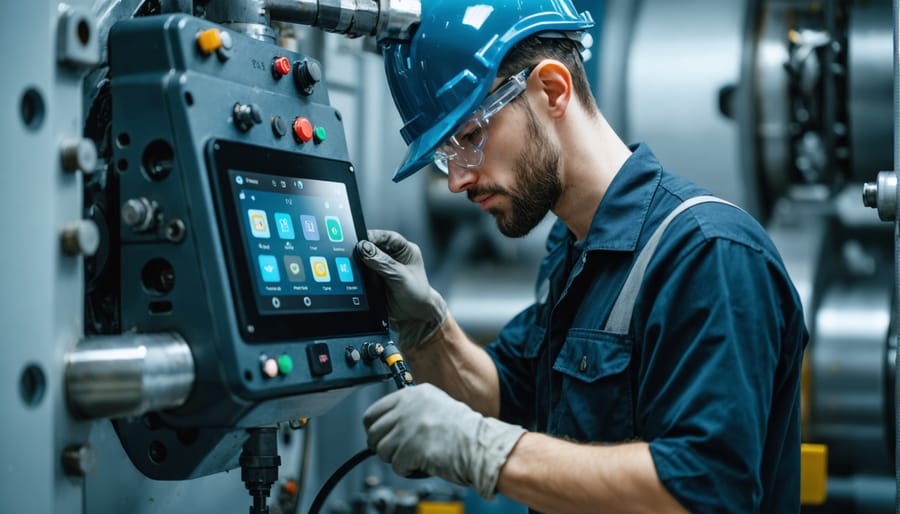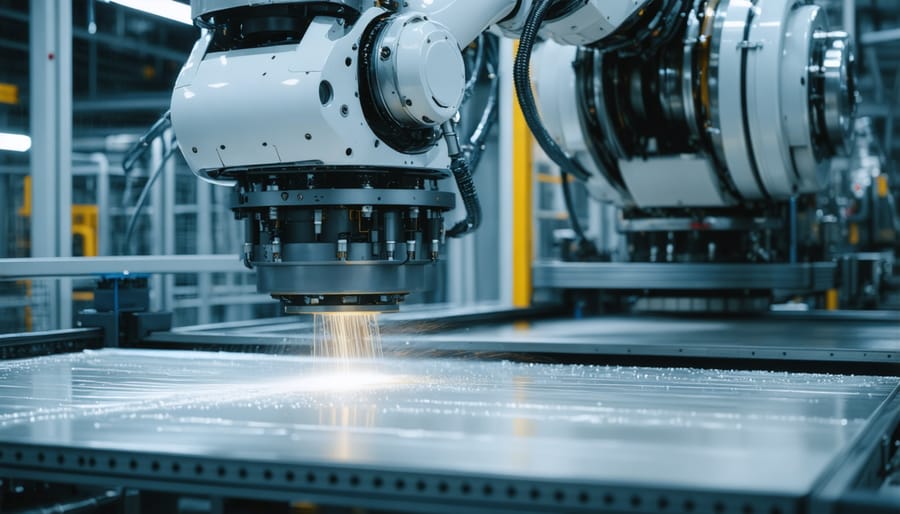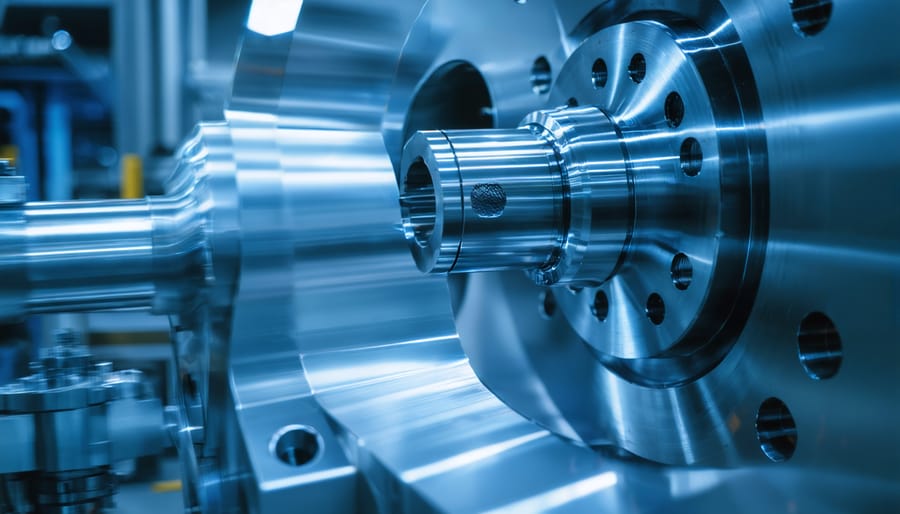Transform your industrial maintenance operations with predictive analytics and IoT sensors that detect equipment failures before they occur, reducing downtime by up to 40%. Modern industrial maintenance demands a strategic blend of cutting-edge technology and time-tested preventive practices to safeguard valuable machinery investments and maintain peak operational efficiency.
Today’s competitive manufacturing landscape requires maintenance solutions that go beyond basic repairs and scheduled checkups. Smart monitoring systems, advanced diagnostic tools, and data-driven maintenance schedules now form the backbone of successful industrial maintenance programs, enabling facilities to optimize performance while minimizing costs.
By implementing comprehensive industrial maintenance solutions, facilities can achieve:
– 25-30% reduction in maintenance costs
– 70-75% decrease in equipment breakdowns
– 35-40% increase in machine lifespan
– Significant improvement in workplace safety
Whether managing a small manufacturing plant or overseeing large-scale industrial operations, the right maintenance strategy combines preventive care, condition monitoring, and strategic planning to ensure continuous production and maximize return on investment. The following guide explores cutting-edge solutions that keep your industrial equipment running at optimal efficiency while protecting your bottom line.
Common Metal Equipment Challenges in Industrial Settings
Corrosion and Rust Issues
Corrosion and rust are among the most persistent challenges in industrial settings, silently attacking metal equipment and infrastructure. When moisture meets metal surfaces, particularly in environments with high humidity or exposure to harsh chemicals, the oxidation process begins. This natural chemical reaction can quickly compromise the integrity of valuable machinery and equipment, leading to costly downtime and repairs.
To combat these issues effectively, facility managers should implement a comprehensive prevention strategy. This includes regular inspections, proper ventilation systems, and the application of protective coatings. When rust does appear, it’s crucial to address it promptly with best rust removal solutions before the damage spreads.
Modern prevention methods include advanced surface treatments, sacrificial anodes for larger equipment, and humidity control systems. Maintaining appropriate environmental conditions and applying corrosion inhibitors can significantly extend equipment life. Remember, the cost of prevention is typically far less than the expense of replacing corroded equipment or dealing with unexpected breakdowns.

Wear and Tear Patterns
Understanding wear and tear patterns is crucial for maintaining industrial equipment effectively. By recognizing these patterns early, you can prevent costly breakdowns and extend machinery life. Common wear patterns include surface abrasion, which appears as scratches or grooves, and impact damage, visible as dents or deformations in metal surfaces.
Pay special attention to high-stress areas where metal components frequently interact. These early warning signs of equipment failure often manifest as uneven wear, discoloration, or unusual sounds during operation. Look for signs of fatigue stress, such as hairline cracks or metal flaking, particularly around welded joints and load-bearing surfaces.
Regular inspection of bearings, gears, and moving parts can reveal telltale signs of wear before they become critical issues. Watch for unusual vibrations, misalignment patterns, or excessive heat generation – these often indicate developing problems. By documenting these patterns over time, you can establish predictive maintenance schedules that address issues before they escalate into major repairs.
Remember, different materials show distinct wear patterns. While softer metals might show immediate surface wear, harder materials could develop internal stress patterns that aren’t immediately visible but are equally concerning.
Preventive Maintenance Strategies

Regular Inspection Protocols
Regular equipment inspection is your first line of defense against costly repairs and unexpected breakdowns. Start by creating a detailed checklist that covers all critical components of your industrial equipment. Begin with visual inspections, looking for obvious signs of wear, rust, or damage that could indicate potential issues. Pay special attention to the effects of environmental exposure on metal surfaces and moving parts.
Set up a systematic approach by dividing inspections into daily, weekly, and monthly tasks. Daily checks should focus on operational basics: unusual sounds, vibrations, or temperature changes. Weekly inspections should delve deeper into mechanical components, checking belt tensions, fluid levels, and bearing conditions. Monthly reviews should be comprehensive, including electrical systems, safety mechanisms, and structural integrity.
Document everything you observe during these inspections. Use a digital maintenance log or smartphone app to track findings, making it easier to spot patterns and predict potential failures. Take photos of concerning areas and maintain a timeline of when issues first appear.
Don’t forget to inspect your maintenance tools as well. Calibration equipment should be regularly tested, and measuring devices should be properly stored and maintained. Keep your inspection area well-lit and organized, with all necessary tools readily available.
Train your team to recognize early warning signs specific to your equipment. This might include unusual odors, changes in operational speed, or variations in product quality. Remember, catching problems early through regular inspection protocols can save significant time and money in the long run.
Cleaning and Surface Treatment
Maintaining clean and well-treated metal surfaces is crucial for extending the life of industrial equipment and preventing costly repairs. The key to effective surface maintenance lies in regular cleaning and proper treatment techniques that protect metal surfaces from damage and deterioration.
Start with a thorough cleaning routine using appropriate industrial cleaners that remove dirt, grease, and contaminants without harming the metal’s finish. For everyday maintenance, a mixture of mild detergent and warm water often suffices, but stubborn buildup may require specialized industrial degreasers. Always test cleaning solutions on a small, inconspicuous area first to ensure compatibility with the metal surface.
After cleaning, proper drying is essential to prevent moisture-related issues like rust and corrosion. Use clean, lint-free cloths and ensure all surfaces are completely dry before applying any protective treatments. Consider using compressed air in hard-to-reach areas where water might collect.
Surface treatment options vary depending on the metal type and its application. Popular choices include:
– Protective coatings and sealants
– Rust inhibitors
– Industrial-grade waxes
– Anti-corrosion sprays
Apply these treatments in thin, even layers, following manufacturer guidelines for optimal results. Regular inspection of treated surfaces helps identify potential issues before they become serious problems. Look for signs of wear, oxidation, or coating breakdown, and address these concerns promptly to maintain the integrity of your metal surfaces.
Remember to document all cleaning and treatment procedures, including products used and application dates, to establish an effective maintenance schedule that ensures consistent care and protection of your industrial equipment.
Modern Maintenance Solutions
Smart Monitoring Systems
In today’s digital age, smart monitoring systems have revolutionized how we approach industrial maintenance. These intelligent solutions combine sensors, data analytics, and cloud connectivity to provide real-time insights into equipment performance. Instead of waiting for something to break, these systems actively track vital signs like temperature, vibration, and pressure, alerting maintenance teams before issues escalate.
Think of these monitoring systems as health trackers for your industrial equipment. Just as a smartwatch monitors your heart rate and activity levels, these systems keep a vigilant eye on your machinery’s vital statistics. They collect and analyze data patterns, learning what’s normal for each piece of equipment and flagging any concerning deviations.
The beauty of smart monitoring lies in its predictive capabilities. By analyzing historical data and current performance metrics, these systems can forecast potential failures weeks or even months in advance. This foresight allows maintenance teams to schedule repairs during planned downtime, avoiding costly emergency shutdowns and production delays.
These systems also make maintenance more efficient by eliminating unnecessary inspections. Rather than following rigid maintenance schedules, teams can focus their efforts where they’re truly needed. Plus, with mobile apps and cloud-based dashboards, maintenance managers can monitor their equipment’s health from anywhere, making informed decisions on the go.
Smart monitoring isn’t just about preventing breakdowns – it’s about optimizing performance and extending equipment life through data-driven maintenance strategies.
Advanced Coating Technologies
The world of protective coatings has evolved dramatically, bringing exciting innovations that revolutionize how we protect industrial equipment. Today’s advanced coating technologies offer unprecedented levels of protection against corrosion, wear, and chemical exposure while being more environmentally friendly than ever before.
Nanotechnology-enhanced coatings represent a game-changing advancement, creating ultra-thin protective layers that bond at the molecular level. These smart coatings can self-heal minor scratches and actively respond to environmental changes, extending equipment life significantly. Some even change color to indicate wear or damage, making maintenance scheduling more precise and proactive.
Eco-friendly powder coatings have gained popularity as a sustainable alternative to traditional liquid-based solutions. These solvent-free options not only reduce environmental impact but also provide superior durability and coverage. The application process is more efficient, with less waste and faster curing times.
Thermal spray coatings have also seen remarkable improvements, now offering ceramic-metallic combinations that provide exceptional heat resistance and wear protection. These hybrid coatings are perfect for high-stress environments where traditional solutions might fail.
The latest anti-microbial coatings incorporate silver ion technology, making them ideal for food processing equipment and medical facilities. These specialized coatings not only protect against corrosion but also prevent bacterial growth, addressing multiple maintenance concerns simultaneously.
Remember to consider your specific application needs when selecting a coating technology, as each innovation brings its own set of advantages for different industrial environments.
Automated Maintenance Systems
In today’s fast-paced industrial environment, automated maintenance systems have revolutionized how we care for metal equipment and machinery. These smart systems combine sensors, software, and artificial intelligence to monitor equipment health in real-time, predicting potential failures before they occur. Think of it as having a 24/7 virtual maintenance team that never takes a break.
Modern automated systems can track various parameters like temperature, vibration, pressure, and wear patterns. When unusual patterns emerge, the system alerts maintenance teams immediately, allowing them to address issues proactively rather than reactively. This predictive approach has shown to reduce downtime by up to 50% in many facilities.
The beauty of automated maintenance lies in its ability to learn and adapt. Using machine learning algorithms, these systems become more accurate over time, fine-tuning their predictions based on historical data and actual equipment performance. They can even generate automated maintenance schedules, ensuring no crucial maintenance task falls through the cracks.
For business owners, the benefits are clear: reduced labor costs, improved equipment reliability, and extended machinery lifespan. While the initial investment might seem substantial, the long-term savings in prevented breakdowns and optimized maintenance schedules typically provide an excellent return on investment within the first few years of implementation.
Remember, though, that automated systems work best when integrated with human expertise – they’re meant to enhance, not replace, skilled maintenance professionals.

Cost-Effective Maintenance Planning
Creating a cost-effective maintenance plan doesn’t have to be overwhelming. Start by conducting a thorough inventory of all your metal equipment and machinery, noting their age, condition, and maintenance history. This baseline information will help you prioritize maintenance tasks and allocate resources efficiently.
Develop a tiered maintenance schedule that balances preventive and reactive maintenance. Consider implementing the 80/20 rule: focus 80% of your resources on preventive maintenance for critical equipment while reserving 20% for unexpected repairs. This approach typically reduces long-term costs by preventing major breakdowns.
When budgeting, factor in both direct costs (parts, labor, materials) and indirect costs (downtime, productivity loss). A good rule of thumb is to allocate 2-5% of your equipment’s replacement value for annual maintenance. Remember to include costs for regular inspections, cleaning, and lubrication – these simple tasks can significantly extend equipment life.
Take advantage of modern maintenance management software to track expenses, schedule tasks, and identify cost-saving opportunities. These tools can help you spot patterns in equipment failures and optimize maintenance intervals based on actual usage rather than fixed schedules.
Build relationships with reliable suppliers and maintenance contractors. Negotiating annual service contracts often proves more economical than paying for individual service calls. Consider training in-house staff for routine maintenance tasks while outsourcing specialized repairs.
Document all maintenance activities and their costs. This data becomes invaluable for future planning and can help justify maintenance investments to management. Regular review of these records can reveal opportunities for efficiency improvements and cost reductions in your maintenance strategy.
Proper metal maintenance isn’t just about keeping equipment running smoothly today – it’s an investment in your facility’s future. Throughout this guide, we’ve explored how comprehensive maintenance solutions combine traditional methods with cutting-edge technologies to protect your valuable industrial assets. By implementing regular inspections, preventive maintenance schedules, and appropriate cleaning protocols, you’re not just avoiding costly breakdowns; you’re extending equipment life and optimizing performance.
Remember that successful maintenance strategies require a balanced approach: combining routine care with advanced monitoring systems, proper staff training, and quality cleaning products. The initial investment in proper maintenance tools and procedures may seem significant, but the long-term benefits far outweigh these costs through reduced downtime, lower repair expenses, and improved operational efficiency.
By adopting these industrial maintenance solutions, you’re not just maintaining equipment – you’re protecting your business’s bottom line, ensuring workplace safety, and contributing to sustainable operations. Make maintenance a priority today, and you’ll reap the rewards for years to come through reliable, efficient, and long-lasting industrial equipment.










